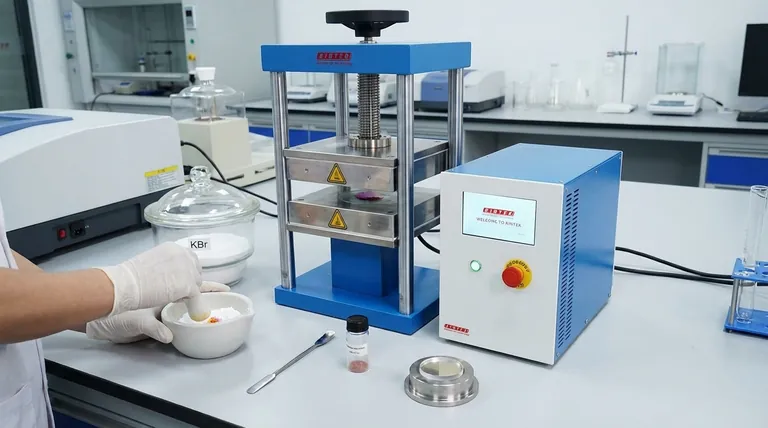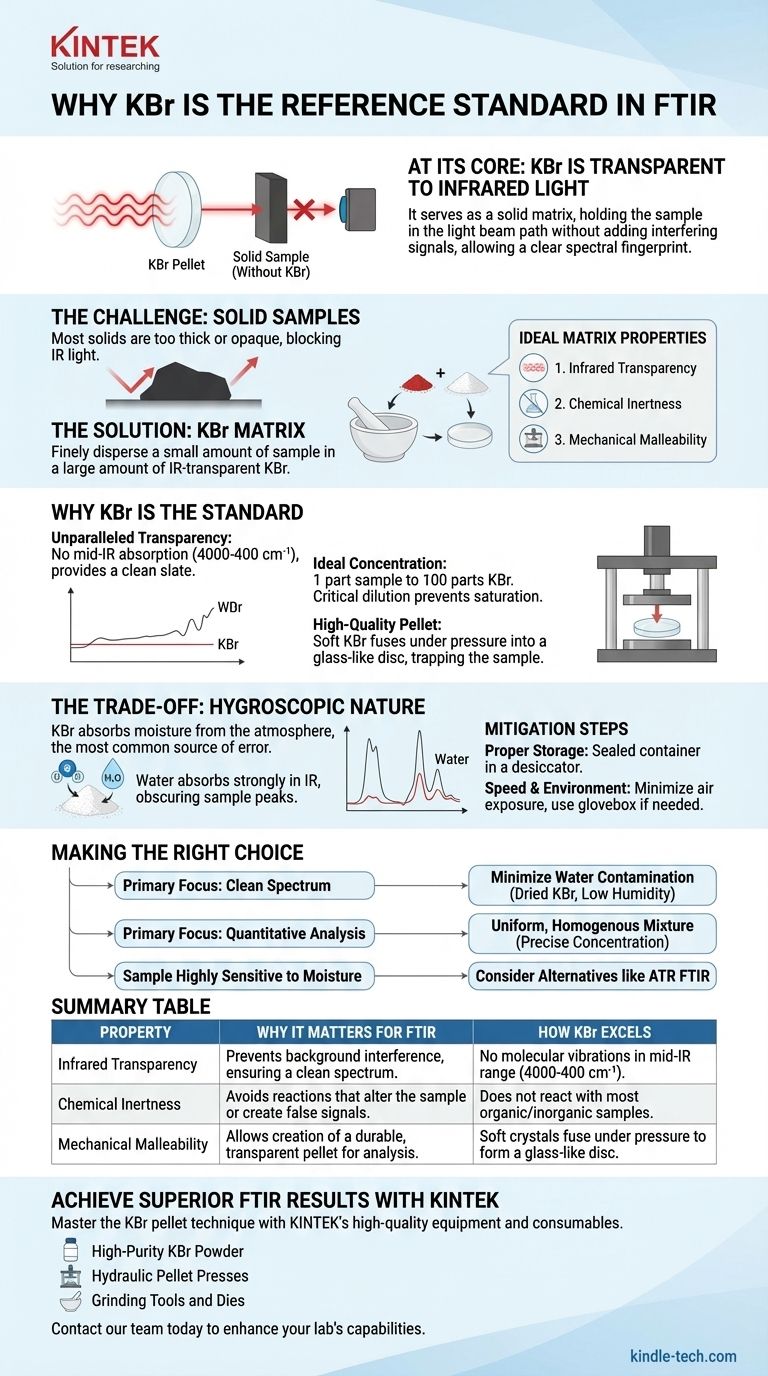根本的に、臭化カリウム(KBr)がFTIR分光法で使用されるのは、赤外光に対して透明であるためです。これは固体マトリックス、または希釈剤として機能し、試料を機器の光ビームの経路内に保持しますが、それ自体の干渉信号を一切追加しません。これにより、試料固有のスペクトルフィンガープリントの明確で妨げられない測定が可能になります。
FTIRで固体試料を分析する際の中核的な課題は、赤外光を効果的に透過させることです。KBrは、目に見えない窓として機能することでこれを解決します。試料を希釈し、透明なペレットにプレスすることを可能にし、得られたスペクトルが試料を保持する材料からではなく、純粋に試料由来であることを保証します。

固体FTIRにおけるマトリックスの役割
固体試料になぜ媒体が必要なのか
ほとんどの固体材料は、赤外ビームが直接通過するには厚すぎるか不透明です。FTIR分光計に固体の塊を入れると、光が遮断され、有用なデータが得られません。
目標は、強度の高い信号を生成するのに十分な量でありながら、光を完全に吸収しない程度の量の材料を分析することです。これは、少量の試料をより大量のIR透過性媒体中に微細に分散させることによって達成されます。
理想的なIRマトリックスの特性
この目的のための理想的なマトリックス材料には、いくつかの重要な特性が必要です。
- 赤外透明性:ほとんどの分析が行われる近赤外領域(通常4000~400 cm⁻¹)で光を吸収してはなりません。
- 化学的不活性:分析対象の試料と反応してはなりません。
- 機械的展延性:柔らかい結晶性材料であり、微粉末に粉砕され、圧力下で耐久性のある透明なディスクにプレスできる必要があります。
KBrはこれら3つの領域すべてで優れており、業界標準となっています。
臭化カリウム(KBr)が標準的な選択肢である理由
比類のない赤外透明性
KBrはイオン性塩であり、近赤外領域でエネルギーを吸収する分子振動を持ちません。この背景信号の完全な欠如により、最終スペクトルで観察されるすべてのピークが試料材料にのみ起因することが保証されます。これは分析のために完全にクリーンな状態を提供します。
理想的な試料濃度の作成
標準的な調製法では、試料とKBr粉末を約試料1部に対しKBr100部の比率で混合します。
この高い希釈率は極めて重要です。これにより、得られたペレットが不透明になりすぎず、試料の吸収ピークが過度に飽和してデータ解釈が困難になるのを防ぎます。
高品質ペレットの形成
乳鉢と乳棒で徹底的に混合・粉砕した後、KBr/試料混合物をダイに入れ、油圧プレスで圧縮します。圧力により、柔らかいKBr結晶が変形して融合し、微細に分散した試料粒子を固体でガラス状のペレット内に閉じ込め、分析に最適化します。
トレードオフの理解:水の問題
KBrの吸湿性
KBrの最も重要な欠点は、吸湿性であり、大気中の湿気を容易に吸収することです。これは、この技術を使用する際の誤差や低品質なスペクトルの最も一般的な原因です。
水分が分析に干渉する方法
水(H₂O)は赤外光を非常に強く吸収し、スペクトルに広くて強いピークを生成します。KBrが水分を吸収している場合、これらの水ピークが試料の重要なピークと容易に重なったり、完全に覆い隠したりして、データの誤解釈につながる可能性があります。
軽減のための実際的な手順
良好な結果を得るためには、水分汚染の管理は不可欠です。
- 適切な保管:KBr粉末は常に密閉容器に入れ、デシケーター内に保管して乾燥した状態を保ちます。
- 速度と環境:空気への暴露を最小限に抑えるため、混合とペレットのプレスをできるだけ速く行います。
- 制御された雰囲気:湿度の高い環境では、水を含まないペレットを生成するために、グローブボックス内での調製や特殊な真空ダイの使用が必要になることがよくあります。
目的のための正しい選択をする
適切なKBr技術は、固体試料からクリーンで信頼性の高いFTIRスペクトルを取得するために不可欠です。
- クリーンでアーティファクトのないスペクトルを得ることが主な焦点である場合:最優先事項は、適切に乾燥させたKBrを使用し、低湿度の環境で作業することにより、水分の汚染を最小限に抑えることです。
- 定量的分析が主な焦点である場合:正確な濃度でKBr内に試料の均一で均質な混合物を得ることが、再現性のある結果のために絶対的に重要です。
- 試料が水分に非常に敏感である場合:KBrペレット法は意図せず水分を導入する可能性があるため、可能であれば減衰全反射(ATR)FTIRなどの代替技術を検討してください。
結局のところ、KBrはFTIR分析のための優れたツールですが、その有効性は注意深く意図的な調製技術に完全に依存します。
要約表:
| 特性 | FTIRにとって重要な理由 | KBrの優れている点 |
|---|---|---|
| 赤外透明性 | バックグラウンド干渉を防ぎ、クリーンなスペクトルを保証する。 | 近赤外領域(4000~400 cm⁻¹)に分子振動がない。 |
| 化学的不活性 | 試料を変化させたり偽の信号を生成したりする反応を避ける。 | ほとんどの有機および無機試料と反応しない。 |
| 機械的展延性 | 分析のための耐久性のある透明なペレットの作成を可能にする。 | 柔らかい結晶が圧力下で融合し、ガラス状のディスクを形成する。 |
KINTEKで優れたFTIR結果を達成
KBrペレット技術を習得することは、固体試料から明確で信頼性の高いFTIRスペクトルを取得するための鍵です。KINTEKは、成功のために必要な高品質の実験用機器と消耗品を提供することに特化しています。
当社が提供するもの:
- 高純度KBr粉末:クリーンなベースラインのために水分汚染を最小限に抑えます。
- 油圧ペレットプレス:均一で透明なペレットを容易に作成します。
- 粉砕ツールとダイ:毎回均質な試料混合物を保証します。
当社の専門知識がお客様の実験室の分析目標をサポートします。今すぐ当社のチームに連絡して、お客様固有のFTIRニーズについてご相談いただき、KINTEKがお客様のラボの能力をどのように向上させられるかをご確認ください。
ビジュアルガイド




















